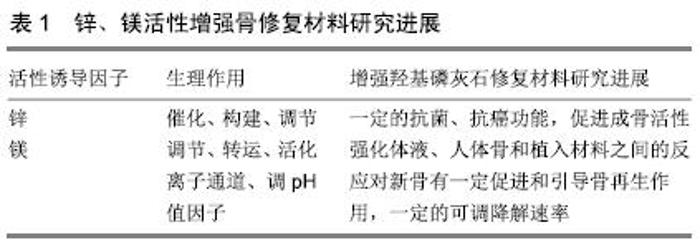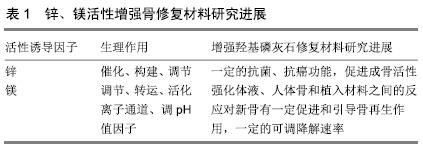Chinese Journal of Tissue Engineering Research ›› 2020, Vol. 24 ›› Issue (4): 606-611.doi: 10.3969/j.issn.2095-4344.1939
Previous Articles Next Articles
Zn and Mg increase the bioactivity and osteogenic induction of hydroxyapatite biomaterial in bone repair: clinical application and mechanism
Zhang Yanan1,2, Yan Xia1,2, Meng Zengdong2, 3
- 1Medical School of Kunming University of Science and Technology; 2Department of Orthopedics, the Affiliated Hospital of Kunming University of Science and Technology; 3Department of Orthopedics, the First People’s Hospital of Yunnan Province
-
Received:2019-04-16Revised:2019-04-20Accepted:2019-06-12Online:2020-02-08Published:2020-01-07 -
Contact:Meng Zengdong, MD, Chief physician, Professor, Department of Orthopedics, the Affiliated Hospital of Kunming University of Science and Technology, Kunming 650032, Yunnan Province, China; Department of Orthopedics, the First People’s Hospital of Yunnan Province, Kunming 650032, Yunnan Province, China -
About author:Zhang Yanan, Master candidate, Medical School of Kunming University of Science and Technology, Kunming 650500, Yunnan Province, China; Department of Orthopedics, the Affiliated Hospital of Kunming University of Science and Technology, Kunming 650032, Yunnan Province, China -
Supported by:the National Natural Science Foundation of China, No. 31860264
CLC Number:
Cite this article
Zhang Yanan, Yan Xia, Meng Zengdong. Zn and Mg increase the bioactivity and osteogenic induction of hydroxyapatite biomaterial in bone repair: clinical application and mechanism [J]. Chinese Journal of Tissue Engineering Research, 2020, 24(4): 606-611.
share this article
Add to citation manager EndNote|Reference Manager|ProCite|BibTeX|RefWorks

2.1 锌、镁掺杂羟基磷灰石的研究背景及概况 羟基磷灰石[Ca10(PO4)6(OH)2]是人体骨骼的主要无机成分,它具有优良的生物相容性/生物活性和骨诱导能力,且已用于各种医疗应用。羟基磷灰石本身可以单独用作生物陶瓷或生物医学工程复合材料的一部分[4-5]。改善羟基磷灰石的生物物理化学性质可用微量元素的离子进行取代,羟基磷灰石中的钙离子具有和二价阳离子相同的价电子,因此这种二价阳离子将会取代钙离子在羟基磷灰石中的晶格位置[6]。此外,二价阳离子在骨骼的重塑过程中除了促进碱性磷酸酶的活性,也有钙化沉积的作用。目前研究较热的二价阳离子是锌离子和镁离子,见表1,在自然骨中除了羟基磷灰石等基本成分外,还含有 Mg、Zn、Na、K、Sr等微量活性元素,其具有较强的成骨诱导能力,能明显提高骨修复过程[7]。"


2.1.1 生理作用 锌是人与动物所必需的微量元素之一,具有催化、构建、调节3种基本作用,它是300多种酶的辅助因子,在代谢、免疫等方面发挥着重要的生理作用。同时,免疫器官的发育也有锌的参与,因此,它与机体的免疫功能有着密切的关联,对机体非特异性和特异性免疫也有影响,包括:参与多种激素和酶的反应、对生物膜的结构和功能有一定的维持作用、动物的免疫能力得到一定的提高、与维生素进行协同作用、影响脑功能、动物的繁殖能力进一步改善等[8]。 镁是活细胞内含量最丰富的阳离子之一,是每个生物学过程所必需的一种辅助因子,它参与调节上百种酶的作用及各种转运蛋白和离子通道的活化。镁离子还是细胞内游离钙离子和pH值的重要调节因子,而这两者是细胞收缩、分泌、运动和增殖的主要决定因素;再者,镁还可通过多种机制调节骨的代谢。另一方面,可降解的镁合金是一类极具潜力的新型生物移植材料,其在生理环境下的降解产物也主要以离子状态存在和发挥作用。另外,镁材料的性质及含镁羟基磷灰石在骨修复材料领域具有广阔的应用前景,但对人生理活动的研究现状和骨代谢调节的机制仍不清楚,需要进一步的研究。 2.1.2 成骨诱导机制研究进展 ALIOUI等[9]用沉淀法合成了一系列掺杂和共掺杂锌和镁离子的合成羟基磷灰石,结果显示从摩尔百分比15%Zn或Mg的这些纳米粉末在体外对5种细菌表现出较强的抗微生物活性。RAJENDRAN等[10]将不同化学计量组成的未取代和多元素(镁、锌和钴)取代的羟基磷灰石进行合成,评估了其形态和结构特征、结晶度、生物活性、细胞毒性和抗菌活性,发现MgZnCo-羟基磷灰石具有更好的生物活性,比未取代羟基磷灰石具有更优的细胞活力和抗菌活性。然而当取代基元素的化学计量比相对较高时,观察到细胞活力和抗菌活性的降低,这可能是高含量的取代破坏了材料的内部结构。可以看到化合物MgZnCo-羟基磷灰石具有良好的生物医学应用前景。石伟等[11]制备了Mg-4Zn合金合成的羟基磷灰石涂层,由于生物可降解镁合金具有高比强度、低弹性模量和优良的生物相容性而受到广泛关注。已有大量研究表明,掺杂锌、镁二价阳离子均可增强羟基磷灰石的体外生物相容性、生物降解性和骨诱导性,相关研究将丰富人工骨修复材料结构设计与可控制备基础理论,对推动羟基磷灰石基骨修复材料临床大量应用具有重要意义。 2.2 锌离子掺杂羟基磷灰石骨修复材料的生物活性 锌是人体中第二丰富的微量金属,该元素总量的约86%位于骨骼肌和骨组织中。骨骼中锌离子的最高比例位于类骨质和非矿化基质中。锌充当许多酶的辅助因子,因此,它参与DNA和RNA复制、蛋白质合成和骨代谢。锌元素能促进成骨细胞的分化和增殖[12]。金属对成骨细胞分化的刺激作用部分归因于它能增强与瘤相关的转录因子2表达的能力,转录因子2是成骨细胞生成中的关键转录因子。体外研究表明锌还能刺激生长因子的成骨细胞生成,同时有实验证据显示锌对碱性磷酸酶具有刺激作用,而碱性磷酸酶可通过有机焦磷酸的去磷酸化促进骨矿化。此外锌离子还可抑制破骨细胞活性。已有体外研究表明,锌对甲状旁腺激素和促炎细胞因子介导的破骨细胞吸收有抑制作用。体内研究则证实了锌对骨细胞活性的特异性影响及其对骨骼系统正常发育的贡献。用雏鸡和大鼠进行的实验表明,补锌可增加骨的强度参数,减少细胞外骨骼吸收标记物,增加骨形成指标的水平[13-14]。 2.2.1 锌离子掺杂羟基磷灰石体外成骨诱导研究进展 锌离子的浓度对体外羟基磷灰石生物性能的影响:研究表明,羟基磷灰石掺杂低浓度的锌离子有利于刺激成骨细胞的增殖和分化,抑制破骨细胞的骨重吸收作 用[15]。但同时要注意,高浓度的锌离子是具有细胞毒性的,有研究指出较高浓度的ZnO量子点会降低细胞的活力,但通常在30 ppm或更低的时候是安全的。该实验通过水分散性ZnO量子点在30 ppm下成功标记肝细胞HepG2、成骨细胞MC3T3-E1和间充质干细胞的细胞系,结果显示ZnO量子点标记的间充质干细胞保持其干燥性和分化的能力,故水分散性ZnO量子点具有抗菌活性和低细胞毒性[16]。但将高浓度锌离子掺入羟基磷灰石具体的不良生物学效应尚缺研究证实,因为羟基磷灰石对锌离子有一定的缓释作用,这会致使锌离子不能在短时间内快速释放,从而产生细胞毒性,因此在添加锌时需要选择有效的缓释体系。 锌离子掺杂羟基磷灰石有抑制炎症及一定的抗菌和抗癌功能:纯羟基磷灰石的假体植入机体后可能会释放磨屑颗粒,磨屑颗粒会被单核细胞吞噬,之后其分泌的细胞因子会引发炎症。GRANDJEAN-LAQUERRIER等[17]将含0.5%-2.0% Zn的羟基磷灰石浸入受脂多糖刺激和未受刺激的单核细胞中,研究Zn含量对破骨细胞因子肿瘤坏死因子α、白细胞介素1β、白细胞介素6、白细胞介素8和白细胞介素10的影响,结果表明肿瘤坏死因子α、白细胞介素1β和白细胞介素6的产量都随Zn含量的增加而减少,而白细胞介素8和白细胞介素10随Zn的增加而增多,从而表明Zn的掺入可抑制炎症反应,促抗发炎细胞的产生。JANA等[18]采用湿化学方法将乙醇、乙醇胺、水和乙醛等不同溶剂合成了不同纳米形态的核壳α-FeO-ZnO结构,通过记录不同时间点的吸光度值发现,材料对革兰阴性霍乱弧菌N16961(VcN16961)和革兰阳性金黄色葡萄球菌都有明显的抗菌功效;通过MTT法评估其对人乳腺癌细胞系MCF-7、人肝癌细胞系HepG2、正常细胞毒性人胚肾细胞系HEK-293细胞的毒性,发现α-FeO-ZnO对HEK-293的毒性较小,对MCF-7和HepG2细胞的有效抗癌活性强调了其作为抗癌剂的适用性。DHIVYA等[19]的实验表明,锌掺杂羟基磷灰石对铜绿假单胞菌和金黄色葡萄球菌具有良好的抗菌活性。孙广飞[20]用锌离子对羟基磷灰石进行结构性取代获得了锌掺杂羟基磷灰石,发现掺杂锌使得羟基磷灰石具有抗菌作用;将合适大小尺寸的复合支架材料植入大鼠颅骨缺损部位,植入后12周处死颅骨缺损部位组织学切片观察发现,锌掺杂羟基磷灰石在大鼠颅骨缺损植入中对免疫细胞有一定的调节促进作用。由此证明,在骨移植支架材料中使用锌掺杂羟基磷灰石具有抗菌和调控免疫细胞的作用,增加了支架材料的附加价值。 2.2.2 锌离子掺杂羟基磷灰石体内成骨诱导研究进展 作为整形外科植入物,需要优化具有可调降解速率的纯Zn和更理想的生物相容性。YANG等[21]的研究表明金属基质复合材料是用于此目的较有前景的方法,金属基质复合材料是以纯Zn作为基质、以羟基磷灰石作为增强材料,通过放电等离子体烧结制备而成的,该研究系统地评估了用作整形外科植入物应用的新型Zn-羟基磷灰石复合材料的可行性:烧结后,羟基磷灰石均匀地分布在Zn颗粒边界中;腐蚀实验表明由于羟基磷灰石的双相效应,Zn-羟基磷灰石复合材料的降解速率是可以调控的,这也是很重要的一部分;而且与纯Zn相比,Zn-羟基磷灰石复合材料显示出更佳胞的细胞活力;纯Zn和复合材料都表现出低的血栓形成风险和溶血率,而锌离子在凝血时间上发现浓度依赖性效应;此外还观察到有效的抗菌性质;植入8周后,纯Zn和含Zn-5%羟基磷灰石复合材料的体积损失分别为1.7%和3.2%;组织学发现在第4周时纯Zn和Zn-5%羟基磷灰石复合物周围可见新形成的骨,随着时间的推移骨量增加,并且随着植入时间的延长,Zn-5%羟基磷灰石复合物在刺激新骨形成方面比纯Zn更有效。这让人们看到了Zn-羟基磷灰石复合材料潜在的研究价值,可在此基础上做更进一步的研究。ZnO纳米颗粒在与羟基磷灰石结合时可增强骨生长并促进成骨细胞的增殖。GNANESHWAR等[22]利用溶胶-凝胶乙醇缩合技术在ZnO中掺入羟基磷灰石,研究人胎儿成骨细胞hFOB与ZnO掺杂羟基磷灰石掺入生物复合材料聚(L-乳酸)-co-聚(ε-己内酯)和丝素蛋白纳米纤维支架之间的相互作用,体外研究表明由于丝素蛋白的存在显示出潜在的拉伸性能(322.4%),添加ZnO和羟基磷灰石增强了骨矿物质基质的分泌(98%),使其纤维直径更小(139.4±27) nm,同时增加了成骨细胞对骨组织再生的增殖。更近一步表明Zn元素的掺杂对成骨活性是有一定的促进作用的,其具体的机制仍需进一步探究。 2.3 镁离子掺杂羟基磷灰石骨修复材料的生物活性 镁离子在骨代谢中起着关键作用,因为它影响成骨细胞和破骨细胞的活性,从而影响骨生长。TER BRAAKE等[23]的研究表明镁可以抑制细胞外空间中羟基磷灰石的形成,从而防止血管平滑肌细胞的钙化。SAHMANI等[24]使用NaCl作为间隔物,借助于空间保持器技术制造羟基磷灰石-MgO支架,实验发现镁对孔隙率没有较为明显的影响,但它会显著提高支架的抗压强度。由于MgO纳米颗粒进入网络,镁离子的存在还导致羟基磷灰石的结晶度降低30-100 nm。与含有10%MgO纳米颗粒的样品相关结果表明,生物纳米复合材料支架的微观结构是具有多孔结构的三维结构,适合作为组织重建的候选材料。 2.3.1 镁离子掺杂羟基磷灰石体外成骨诱导研究进展 镁是人体中第四丰富的元素,存在于骨骼、牙本质和牙釉质中。多达60%的镁沉积在身体总骨骼中,骨骼充当金属的天然储存器。骨骼中的镁位于羟基磷灰石表面或晶体周围的水合层[25],镁有助于维持矿化组织的体内平衡,适当水平的金属对于预防骨质疏松症和其他骨组织损伤至关重要。元素对矿化组织的影响既是直接的也是间接的[26],直接影响是镁对骨晶体结构和骨骼细胞活性具有显著影响,镁缺乏会立即导致低镁血症,这可以通过调动骨沉积来补偿;反过来镁过量会导致生物磷灰石结构的改变,从而使机械强度降低。体外和体内研究均证实该元素对骨细胞活性的影响:即镁能刺激成骨细胞活性[27];另一方面,镁金属缺乏会促进低度炎症,并因此导致破骨细胞活性增加,从而导致骨量减少。在其间接作用中,镁对甲状旁腺激素的分泌有影响,从而分泌1.25(OH)2维生素D。实验表明金属短缺降低了血清中甲状旁腺激素和维生素D的浓度,从而导致低钙血症。细菌和宿主细胞之间的表面定植竞争,是骨植入物进入整合期间涉及到的关键因素之一。ANDRéS等[28]研究了Mg2+取代纳米结构羟基磷灰石的抗菌能力,发现Mg2+羟基磷灰石的抗菌作用与材料表面形貌及其电活性有关,这样的结果强化了Mg-羟基磷灰石纳米结构材料用于植入装置或药材的抗菌涂层能力,防止骨感染和促进伤口愈合。WETTELAND[29]通过纯机械刺激增加纳米MgO在聚乳酸共羟基乙酸中的分散,发现纳米MgO可用于骨再生材料的有用添加剂。此外,镁掺杂羟基磷灰石可作为载体负载抗癌药物,并可一定程度抑制癌细胞的生长[30]。 2.3.2 镁离子掺杂羟基磷灰石体内成骨诱导研究进展 NYGREN等[31]将MgO植入物插入大鼠胫骨中,愈合1周后的元素分析中显示,MgO处理的动物骨髓中Ca(7.1%)、P(3.7%)和Mg(0.2%)水平较假手术对照组增加;MgO处理的动物皮质骨Ca含量也较假手术对照组显著增加(Ca,29%增加),假手术对照组动物皮质骨的Ca含量也显著高于未治疗动物的相应值(P < 0.05),这意味着手术创伤诱导骨矿物质组成发生了改变,而金属形式的镁(镁金属)和氧化镁(MgO)刺激骨愈合的不同能力是寻找可促进骨愈合的产品的可能线索。CRESPI等[32]通过组织形态学和离体基因表达谱分析比较富镁羟基磷灰石与自体骨移植在上颌窦提升程序中的应用效果,15例患者接受自体骨颗粒(A组)和富镁羟基磷灰石(B组),组织形态学分析发现自体骨标本比富镁羟基磷灰石移植部位具有更高的生命活力,且富镁羟基磷灰石移植物成骨细胞基因表达谱显示,成骨细胞分化和骨形成的特定标记物表达较高,而破骨潜能较低,相关研究需进一步深入。DENG等[33]通过在材料中掺杂Mg来修改羟基磷灰石,并在山羊模型中使用Mg羟基磷灰石和重组人骨形态发生蛋白2对颅骨缺损修复效果进行了评估,体内实验发现Mg对骨形成和血管生成有影响,Mg羟基磷灰石/重组人骨形态发生蛋白2改善了骨缺损修复效果,是值得推荐用于骨组织工程的。LANDI等[34]研究了Mg-羟基磷灰石的成骨活性,将粉末法制备的Mg-羟基磷灰石复合颗粒填充在大白兔股骨内,结果发现Mg-羟基磷灰石的骨传导性和吸收性均比纯羟基磷灰石骨修复材料有所提。Mg-羟基磷灰石骨修复材料的长期动物实验发现,材料能够强化体液、人体骨和植入材料之间的化学反应,对新骨在植入材料上的形成有一定促进作用和引导骨再生作用[35-36],可使初期的降解速率受到一定控制[37]。虽然镁离子掺杂羟基磷灰石在生物机体内具有良好的生物降解性和理想的骨修复效果,但和锌离子掺杂羟基磷灰石一样,目前还停留在动物实验阶段,在临床上尚未有实际应用。 "

| [1] ORYAN A, ALIDADI S, BIGHAM-SADEGH A, et al. Comparative study on the role of gelatin, chitosan and their combination as tissue engineered scaffolds on healing and regeneration of critical sized bone defects: an in vivo study.J Mater Sci Mater Med. 2016; 27(10):155. [2] GARCÍA-GARETA E, COATHUP MJ, BLUNN GW. Osteoinduction of bone grafting materials for bone repair and regeneration. Bone. 2015;81:112-121. [3] BASHA RY, SANPATH KTS, DOBLE M.Design of bio composite materials for bone tissue regeneration. MaterSci Eng C. 2015;57: 452-463. [4] LEI Y, XU Z, KE Q, et al.Strontium hydroxyapatite/chitosan nanohybrid scaffolds with enhanced osteoinductivity for bone tissue engineering.Mater Sci Eng C Mater Biol Appl. 2017;72: 134-142. [5] TERUKINA T, SAITO H, TOMITA Y, et al.Development and effect of a sustainable and controllable simvastatin-releasing device based on PLGA microspheres/carbonate apatite cement composite: In vitro evaluation for use as a drug delivery system from bone-like biomaterial.J Drug Deliv Sci Technol. 2016;37:74-80. [6] RATNAYAKE JTB, MUCALO M, DIAS GJ.Substituted hydroxyapatites for bone regeneration: A review of current trends.J Biomed Mater Res B Appl Biomater. 2017;105(5): 1285-1299. [7] 吴兰.人骨与纳米骨修复材料的比较研究[D].成都:四川大学, 2006. [8] 韩金凤,彭豫东,付莹,等.锌的生理作用及其对仔猪生长性能和免疫力的影响[J].饲料博览,2016,29(4):43-45. [9] ALIOUI H, BOURAS O, BOLLINGER JC.Toward an efficient antibacterial agent: Zn- and Mg-doped hydroxyapatite nanopowders.J Environ Sci Health A Tox Hazard Subst Environ Eng. 2019;54(4):315-327. [10] RAJENDRAN A, BALAKRISHNAN S, KULANDAIVELU R, et al. Multi-element substituted hydroxyapatites: synthesis, structural characteristics and evaluation of their bioactivity, cell viability, and antibacterial activity. J Sol-Gel Sci Technol. 2018;86(2):441-458. [11] 石伟,赵大鹏,尚鹏,等.Mg-4Zn合金表面掺锶羟基磷灰石涂层:物理化学性质及体外细胞响应[J].稀有金属材料与工程, 2018,47(8): 2371-2380. [12] BOANINI E, GAZZANO M, BIGI A.Ionic substitutions in calcium phosphates synthesized at low temperature.Acta Biomater. 2010;6(6):1882-1894. [13] KWIECIEŃ M, WINIARSKA-MIECZAN A, MILCZAREK A, et al. Effects of zinc glycine chelate on growth performance, carcass characteristics, bone quality, and mineral content in bone of broiler chicken. Livestock Sci.2016;191:43-50. [14] HADLEY KB, NEWMAN SM, HUNT JR.Dietary zinc reduces osteoclast resorption activities and increases markers of osteoblast differentiation, matrix maturation, and mineralization in the long bones of growing rats.J Nutr Biochem. 2010;21(4): 297-303. [15] SHEPHERD DV, KAUPPINEN K, BROOKS RA, et al.An in vitro study into the effect of zinc substituted hydroxyapatite on osteoclast number and activity.J Biomed Mater Res A. 2015; 102(11):4136-4141. [16] HSU SH, LIN YY, HUANG S, et al.Synthesis of water-dispersible zinc oxide quantum dots with antibacterial activity and low cytotoxicity for cell labeling. Nanotechnology. 2013;24(47): 475102. [17] GRANDJEAN-LAQUERRIERE A, LAQUERRIERE P, Jallot E, et al. Influence of the zinc concentration of sol-gel derived zinc substituted hydroxyapatite on cytokine production by human monocytes in vitro.Biomaterials.2006;27(17):3195-3200. [18] JANA TK, JANA SK, KUMAR A, et al.The antibacterial and anticancer properties of zinc oxide coated iron oxide nanotextured composites.Colloids Surf B Biointerfaces. 2019; 177:512-519. [19] DHIVYA S, SARAVANAN S, SASTRY TP, et al. Nanohydroxyapatite-reinforced chitosan composite hydrogel for bone tissue repair in vitro and in vivo.J Nanobiotechnology. 2015;13(1):40-40. [20] 孙广飞.锌掺杂羟基磷灰石复合支架制备及抗菌抗炎性能[D].武汉:华中科技大学,2016. [21] YANG H, QU X, LIN W, et al.In vitro and in vivo studies on zinc-hydroxyapatite composites as novel biodegradable metal matrix composite for orthopedic applications.Acta Biomater. 2018;71:200-214. [22] GNANESHWAR PV, SUDAKARAN SV, ABISEGAPRIYAN S, et al. Ramification of zinc oxide doped hydroxyapatite biocomposites for the mineralization of osteoblasts.Mater Sci Eng C Mater Biol Appl. 2019;96:337-346. [23] TER BRAAKE AD, TINNEMANS PT, SHANAHAN CM, et al. Magnesium prevents vascular calcification in vitro by inhibition of hydroxyapatite crystal formation.Sci Rep. 2018;8(1):2069. [24] SAHMANI S, SABER-SAMANDARI S, KHANDAN A, et al. Influence of MgO nanoparticles on the mechanical properties of coated hydroxyapatite nanocomposite scaffolds produced via space holder technique: Fabrication, characterization and simulation. J Mech Behav Biomed Mater.2019;95:76-88. [25] ALSHEMARY AZ, AKRAM M, GOH YF, et al.Synthesis, characterization, in vitro bioactivity and antimicrobial activity of magnesium and nickel doped silicate hydroxyapatite.J Ceramic Int.2015;41(9):11886-11898. [26] CASTIGLIONI S, CAZZANIGA A, ALBISETTI W, et al. Magnesium and osteoporosis: current state of knowledge and future research directions.Nutrients.2013;5(8):3022-3033. [27] HE LY, ZHANG XM, LIU B, et al.Effect of magnesium ion on human osteoblast activity.Braz J Med Biol Res.2016;49(7).pii: S0100-879X2016000700604. [28] ANDRÉS NC, SIEBEN JM, BALDINI M, et al.Electroactive Mg2+ Hydroxyapatite Nanostructured Networks against Drug- Resistance Bone Infection Strains.ACS App Mater Interfaces. 2018;10(23):19534-19544. [29] WETTELAND CL.Magnesium Oxide Based Nanocomposites for Bone Repair.UC Riverside,2017. [30] 马晓雨,刘永佳,朱邦尚.镁掺杂纳米羟基磷灰石的制备及其在载药方面的应用[J].无机化学学报,2018,34(5):e917-e924. [31] NYGREN H, BIGDELI N, ILVER L, et al.Mg-corrosion, hydroxyapatite, and bone healing. Biointerphases. 2017;12(2): 02C407. [32] CRESPI R, MARIANI E, BENASCIUTTI E, et al. Magnesium- enriched hydroxyapatite versus autologous bone in maxillary sinus grafting: combining histomorphometry with osteoblast gene expression profiles ex vivo.J Periodontol. 2017;80(4):586-593. [33] DENG L, LI D, YANG Z, et al.Repair of the calvarial defect in goat model using magnesium-doped porous hydroxyapatite combined with recombinant human bone morphogenetic protein-2.Biomed Mater Eng. 2017;28(4):361-377. [34] LANDI E, LOGROSCINO G, PROIETTI L, et al.Biomimetic Mg-substituted hydroxyapatite: from synthesis to in vivo behaviour. J Mater Sci Mater Med.2008;19(1):239-247. [35] 车鸿泽,车彦海,卢晴,等.PLGA涂层处理的nHA-Mg多孔复合材料对兔颌骨缺损的修复作用[J].吉林大学学报(医学版), 2017, 43(2): 276-280. [36] SARTORI M, GIAVARESI G, TSCHON M, et al.Long-term in vivo experimental investigations on magnesium doped hydroxyapatite bone substitutes.J Mater Sci Mater Med. 2014;25(6):1495-1504. [37] 皮国富,王义生,刘宏建,等.羟基磷灰石涂层镁合金材料体内降解及生物相容性研究[J]中华实验外科杂志, 2010,27(8): 1162-1164. [38] LI H, ZHENG Y, LING Q.Progress of biodegradable metals.Prog Nat Sci Mater Int.2014;24(5):414-422. [39] BYEON IS, HWANG IJ, CHOE HC, et al.Electrochemically-coated hydroxyapatite films on nanotubular Ti Nb alloys prepared in solutions containing Ca,P,and Zn ions.J Thin Solid Films. 2016; 620:132-138. [40] SOON LL, ZUHAILAWATI H, SUHAINA I, et al.Prediction of Compressive Strength of Biodegradable Mg–Zn/HA Composite via Response Surface Methodology and Its Biodegradation.J Acta Metallurgica Sinica. 2016;29(5): 464-474. |
| [1] | Liu Jiangfeng. Nano-hydroxyapatite/polyamide 66 composite filling combined with locking plate in the treatment of fibrous dysplasia of femoral bone [J]. Chinese Journal of Tissue Engineering Research, 2021, 25(4): 542-547. |
| [2] | Li Xiaozhuang, Duan Hao, Wang Weizhou, Tang Zhihong, Wang Yanghao, He Fei. Application of bone tissue engineering materials in the treatment of bone defect diseases in vivo [J]. Chinese Journal of Tissue Engineering Research, 2021, 25(4): 626-631. |
| [3] | Wang Qiufei, Gu Ye, Peng Yuqin, Xue Feng, Ju Rong, Zhu Feng, Wang Yijun, Geng Dechun, Xu Yaozeng. Effect of Wnt/beta-catenin signaling pathway on osteoblasts under the action of wear particles [J]. Chinese Journal of Tissue Engineering Research, 2021, 25(24): 3894-3901. |
| [4] | Tang Xiaokai, Li Weiming. Role and mechanism of Nel-like molecule-1 in promoting bone fusion after spinal fusion [J]. Chinese Journal of Tissue Engineering Research, 2021, 25(24): 3914-3920. |
| [5] | Zhou Wu, Wang Binping, Wang Yawen, Cheng Yanan, Huang Xieshan. Transforming growth factor beta combined with bone morphogenetic protein-2 induces the proliferation and differentiation of mouse MC3T3-E1 cells [J]. Chinese Journal of Tissue Engineering Research, 2021, 25(23): 3630-3635. |
| [6] | Yang Caihui, Liu Qicheng, Dong Ming, Wang Lina, Zuo Meina, Lu Ying, Niu Weidong. Serine/threonine protein kinases can promote bone destruction in mouse models of chronic periapical periodontitis [J]. Chinese Journal of Tissue Engineering Research, 2021, 25(23): 3654-3659. |
| [7] | He Lin, Wu Xi, He Song, Yang Sen. Hydrophilicity and cell adhesion of hydroxyapatite bioceramics after the coating of polydopamine [J]. Chinese Journal of Tissue Engineering Research, 2021, 25(22): 3540-3544. |
| [8] | Huo Hua, Cheng Yuting, Zhou Qian, Qi Yuhan, Wu Chao, Shi Qianhui, Yang Tongjing, Liao Jian, Hong Wei. Effects of drug coating on implant surface on the osseointegration [J]. Chinese Journal of Tissue Engineering Research, 2021, 25(22): 3558-3564. |
| [9] | Zhang Zhenhua, Liu Zichen, Yu Baoqing. Status and problems of polycaprolactone and its composite materials in bone tissue engineering [J]. Chinese Journal of Tissue Engineering Research, 2021, 25(22): 3571-3577. |
| [10] | Jiang Shengyuan, Li Dan, Jiang Jianhao, Shang-you Yang, Yang Shuye. Biological response of Co2+ to preosteoblasts during aseptic loosening of the prosthesis [J]. Chinese Journal of Tissue Engineering Research, 2021, 25(21): 3292-3299. |
| [11] | Wei Qin, Zhang Xue, Ma Lei, Li Zhiqiang, Shou Xi, Duan Mingjun, Wu Shuo, Jia Qiyu, Ma Chuang. Platelet-derived growth factor-BB induces the differentiation of rat bone marrow mesenchymal stem cells into osteoblasts [J]. Chinese Journal of Tissue Engineering Research, 2021, 25(19): 2953-2957. |
| [12] | Guo Zhibin, Wu Chunfang, Liu Zihong, Zhang Yuying, Chi Bojing, Wang Bao, Ma Chao, Zhang Guobin, Tian Faming. Simvastatin stimulates osteogenic differentiation of bone marrow mesenchymal stem cells [J]. Chinese Journal of Tissue Engineering Research, 2021, 25(19): 2963-2968. |
| [13] | Jiang Tao, Ling Cuimin, Chen Qingzhen, Yang Bingxuan, Lin Yanping, Shao Min. Icariin prevents osteoporosis by activating autophagy and promoting osteoblast differentiation [J]. Chinese Journal of Tissue Engineering Research, 2021, 25(17): 2643-2649. |
| [14] | Ailimaierdan·Ainiwaer, Wang Ling, Gu Li, Dilidaer•Taxifulati, Wang Shan, Yin Hongbin. Effect of transforming growth factor-beta3 on the proliferation and osteogenic capability of osteoblasts [J]. Chinese Journal of Tissue Engineering Research, 2021, 25(17): 2664-2669. |
| [15] | Wang Renxian, Cao Jingjing, Wang Honggang, Wan Ben, Liu Weifeng. Effects of dispersants on aggregation, intracellular distribution and cell proliferation of nano-hydroxyapatite [J]. Chinese Journal of Tissue Engineering Research, 2021, 25(16): 2500-2505. |
| Viewed | ||||||
|
Full text |
|
|||||
|
Abstract |
|
|||||